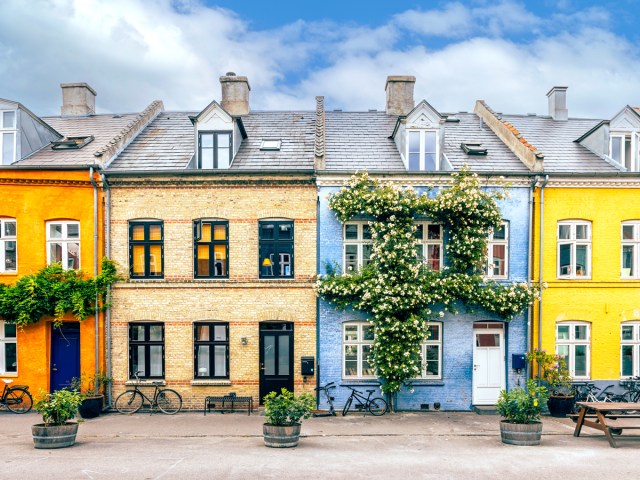The U.S. is home to a fascinating array of architectural styles and landmark buildings. Some represent foundational moments in the country’s history, while others reflect the nation’s ever-forward thinking, using technology and construction methods to create structures that were previously thought to be impossible to build. From the birthplace of the skyscraper to the center of historic Puebloan adobe architecture, these six U.S. cities should be on any architectural buff’s travel bucket list.
Chicago, Illinois

The world’s first first modern skyscraper debuted in 1885 on the corner of Adams and LaSalle Streets in downtown Chicago. Just as you’ll find in New York City, the jumble of glass and steel of the Loop’s high rises reflects a continuing love affair with these supertall buildings. Some of Chicago’s most famous skyscrapers include the 1,450-foot tall Willis Tower — the tallest in the city and the tallest in the world from 1973 to 1998 — and the neo-Gothic Tribune Tower. Completed in 1922, the latter incorporates pieces from some of the world’s most famous structures, including the Taj Mahal and the Great Wall of China, into its striking facade.
Yet, when it comes to architecture, this Midwestern city is no one-trick pony. Architecture buffs should also make their way to Chicago’s southern suburbs to explore the Pullman National Historic Park. This 19th-century planned development was the brainchild of railroad magnate George Pullman, who dreamt of an industrial utopia where his workers could live in comfortable conditions within walking distance of their jobs at the Pullman Palace Car Works. Later designated the first national park unit in the city of Chicago, the community is a noteworthy example of planned urban design and historic architecture.
San Francisco, California

Construction in San Francisco accelerated as a result of the influx of residents during the California Gold Rush, which began in 1848, and was temporarily halted by the Great Earthquake of 1906. The most flamboyant of the Victorian- and Edwardian-era buildings from this period were built in the Queen Anne style and date from 1880 to 1900. These magnificent homes feature an asymmetrical facade, pedimented porches, gabled roofs, balconies, and ornate architectural details such as spindles and fretwork.
The Painted Ladies of Steiner Street, lining the eastern edge of Alamo Square Park, are perhaps San Francisco’s most famous Queen Anne buildings. Developer Matthew Kavanaugh built these homes between 1892 and 1896. Their pretty pastel paintwork echoes the color palette of Miami’s tropical-inspired Art Deco buildings, and as with Florida’s South Beach, they’ve since become one of the most photographed spots in the city.
New Orleans, Louisiana

The Big Easy’s varied neighborhoods are a treasure trove of historic architecture, from the wrought iron balconies of the Vieux Carré (French Quarter) to the stately homes of St. Charles Avenue. The Faubourg Marigny district in New Orleans was laid out at the beginning of the 19th century on plantation land owned by Bernard Philippe Xavier de Marigny de Mandeville. The neighborhood’s trapezoid shape accommodates a meander in the Mississippi River, and its historic streets offer up a melting pot of architectural influences, from French to Spanish and Creole styles.
Here, you’ll find colorful shotgun houses and shuttered Creole cottages alongside two-story buildings adorned with wrought iron balconies and galleries. (There’s a difference: Balconies are designed to be self-supporting, while galleries are propped up on poles.) Examples of Greek, Italianate, and Craftsmen architecture are also found in the neighborhood, which has a bohemian and lively feel, particularly on Frenchmen Street.
Boston, Massachusetts

Architecture buffs can step back in time to the late 17th and early 18th centuries as they explore Boston, one of America’s oldest cities. The oldest building in downtown Boston is the Paul Revere House, constructed around 1680. Nearby, you’ll see the Old Massachusetts State House (built in 1713); the Old Corner Bookstore, Boston’s oldest commercial building (erected in 1718); and Faneuil Hall (dating to 1742), named for the wealthy merchant who gifted it to the city on its completion. They are all stops on the city’s 2.5-mile-long Freedom Trail, a must for any visitor.
However, Boston’s reputation extends far beyond those early days. For instance, the Brutalist-style Boston City Hall and Paul Rudolph’s Lindemann Center each make a bold statement, while landmarks from famed architects Frank Gehry (the Stata Center) and Eero Saarinen (Kresge Auditorium) in nearby Cambridge confront, challenge, and cheer in equal measure.
Santa Fe, New Mexico

Santa Fe boasts some of the most eye-catching architecture in the U.S. This historic New Mexico city, also one of America’s oldest settlements, is proud of its long heritage and celebrates it with the conservation of the adobe buildings built by the region’s Indigenous Puebloans as early as 800 CE.
The Puebloans layered adobe onto a basic wooden framework of vigas and latillas, and the Spanish later adapted the technique in the 16th century by filling wooden molds to make brick and then spreading a thin layer of adobe over the rough walls to retain the smooth, rounded finish that we still admire today. Features such as covered porches (portales), arches set within interior walls (nichos) and kiva fireplaces also originated during this period. Be sure to seek out landmark buildings such as La Fonda on the Plaza, San Miguel Chapel, and the Palace of the Governors as you stroll around.
Seattle, Washington

The Emerald City’s architecture offers an enchanting mix of past and present, from the historic Pike Place Market to the modern and striking glass exterior of the Seattle Central Library. But if there’s one reason for architecture lovers to pay a visit to Seattle, it’s to ascend the Space Needle. And surprisingly, this iconic tower started out as a doodle scribbled on a napkin. The man who drew it, Edward E. Carlson, was a key player in the preparations for the world’s fair that the city was due to host in 1962. This would be its centerpiece, but its legacy would be as an enduring fixture of the Seattle skyline.
Architects John Graham and Victor Steinbrueck each refined the idea for the Space Needle, giving it a waist and a flying saucer-shaped top. The construction process was also impressive, involving the largest continuous concrete pour that had ever taken place in the western U.S. Around 2.65 million visitors came to admire it during the Century 21 Exposition, with many millions more to follow. After an ambitious recent facelift, the upper observation deck now connects to a revolving glass floor below, the first of its kind in the world.





















